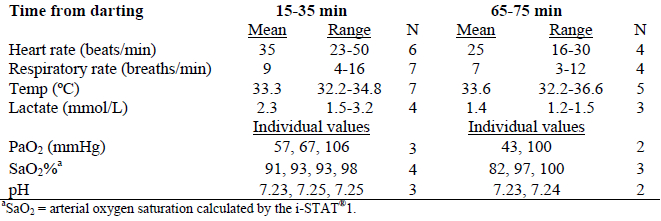Capture and Anesthesia of Free-Ranging Brown Bears (Ursus arctos) During Hibernation
American Association of Zoo Veterinarians Conference 2010
Alina Evans1,2, DVM, MPH; Knut Madslien3, DVM; Åsa Fahlman4,5, DVM, VetMedLic, PhD; Sven Brunberg6; Ole-Gunnar Støen7, PhD; Ole Fröbert8, MD, PhD; Jon E. Swenson7,9, PhD, DrHabil; Jon M. Arnemo1,10, DVM, PhD
1Faculty of Forestry and Wildlife Management, Hedmark University College, Elverum, Norway; 2Section of Arctic Veterinary Medicine, Norwegian School of Veterinary Science, Tromsø, Norway; 3Section of Wildlife Diseases, National Veterinary Institute, Oslo, Norway; 4Department of Veterinary Clinical and Diagnostic Sciences, Faculty of Veterinary Medicine, University of Calgary, Calgary, AB, Canada; 5Section of Anesthesiology, Department of Clinical Sciences, Faculty of Veterinary Medicine and Animal Science, Swedish University of Agricultural Sciences, Uppsala, Sweden; 6Scandinavian Brown Bear Research Project, Tackåsen, Orsa, Sweden; 7Department of Ecology and Natural Resource Management, Norwegian University of Life Sciences, Norway; 8Department of Cardiology, Örebro University Hospital, Örebro Sweden; 9Norwegian Institute for Nature Research, Trondheim, Norway, 10Department of Wildlife, Fish and Environmental Studies, Faculty of Forest Sciences, Swedish University of Agricultural Sciences, Umeå, Sweden
Abstract
We immobilized seven hibernating subadult (2- to 3-year-old) brown bears (Ursus arctos) in central Sweden in February 2010 as part of comparative physiologic research. Bears were located with VHF radio tracking. Snow over the den entrance was uncovered with a shovel. Five bears were darted through a metal grate placed over the den entrance. Two bears in rock dens found alternate escape routes and were darted outside the den. For anesthesia, medetomidine (Domitor®) at 0.02–0.06 mg/kg and zolazepam-tiletamine (Zoletil®) at 1.2–2.8 mg/kg were used. In four bears, ketamine (Narketan®) at 1.5 mg/kg was added to the dart or hand injected before handling. Bears weighed 45–54 kg. Once anesthetized, bears were removed from the dens for monitoring and sample collection. In four bears, arterial blood samples were tested with an iSTAT®1 Analyzer (CG4+ and EC8+, Abbot Laboratories, Abbot Park, Illinois, USA). The bears were placed back in the dens, covered with branches, and reversed with atipamezole (Antisedan®) at 5 mg/kg of medetomidine. The branches were covered with snow and the bears were left to recover undisturbed.
The drugs and doses provided adequate anesthesia for the procedures performed. Physiologic variables during anesthesia are presented in Table 1. Oxygen supplementation (2 L/min) provided to one bear markedly increased arterial oxygenation. Hypoxemia was recorded in two of four bears (PaO2 43–67 mm Hg). All bears survived and emerged from the dens during April 2010. This is the first report of capture and anesthesia in free-ranging brown bears during hibernation.
Table 1. Physiologic variables during anesthesia of hibernating brown bears

Partial pressure of arterial oxygen (PaO2) and pH were corrected to the rectal temperature.